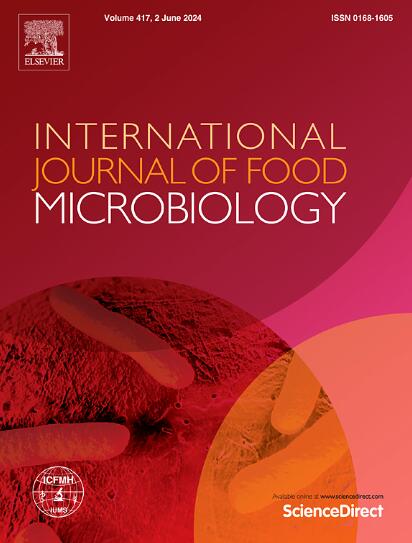Synthetic microbial community mimicking kefir for investigating community dynamics and interspecies interactions
IF 5
1区 农林科学
Q1 FOOD SCIENCE & TECHNOLOGY
International journal of food microbiology
Pub Date : 2025-07-15
DOI:10.1016/j.ijfoodmicro.2025.111345
引用次数: 0
Abstract
Kefir grains serve as natural dairy starter cultures, surviving in high-altitude environments with low temperatures and limited oxygen, while maintaining robust fermentation capabilities. In this study, we reconstructed a synthetic microbial community (SMC) within the kefir microbial ecosystem and explored the strategies that keep this SMC stable and functioning within the complex environment. We investigated the interactions among kefir species by comparing their symbiotic capabilities, milk acidification properties, and fermentation profiles during growth in both individual cultures and co-cultures across various media. Additionally, to deepen our understanding of system-level responses within the SMC, we integrated metabolomics with pure culture techniques to elucidate the mechanisms that enable coexistence among SMC members. The composition of the SMC in fermented milk was determined through co-cultivation assessments and flavor profile analysis, which identified the key members as Lactobacillus kefiranofaciens CZ22, Lactococcus lactis CZ19, and Saccharomyces cerevisiae Y8. The fermented milk produced by SMC shared identical volatile compound profiles with traditional kefir milk, including seven alcohols, seven aldehydes, six ketones, five esters, two carboxylic acids, two ethers, one acyl compound, and five miscellaneous volatile compounds. Our findings revealed that the coexistence mechanism among these three species is based on cross-feeding interactions. Lc. lactis CZ19 provides L. kefiranofaciens CZ22 with amino acids such as tyrosine, proline, and arginine, promoting its growth. Moreover, S. cerevisiae Y8 supplies primary metabolic products, including purines, pyrimidines, and nucleotides, to L. kefiranofaciens CZ22, facilitating the coexistence of all three species. During the fermentation process of the SMC, L. kefiranofaciens CZ22 maintained high abundance and accelerated acidification and enhanced flavor volatiles in milk. The SMC we constructed effectively maintained the core kefir species and fermentation performance of kefir starter cultures, simplified the complex fermentation system and laid the groundwork for the modernization and improvement of the production process. This study systematically elucidates the coexistence strategies employed by synthetic microbial systems in fermented milk production, while enhancing our understanding of microbial interactions in traditional fermented foods.
模拟开菲尔的合成微生物群落研究群落动态和种间相互作用
开菲尔谷物作为天然的乳制品发酵剂,在低温和氧气有限的高海拔环境中存活,同时保持强大的发酵能力。在本研究中,我们在开菲尔菌生态系统中重建了一个合成微生物群落(SMC),并探索了在复杂环境中保持SMC稳定和功能的策略。我们研究了开菲尔种之间的相互作用,通过比较它们的共生能力、牛奶酸化特性和在不同培养基上的单独培养和共同培养过程中的发酵特征。此外,为了加深我们对SMC系统水平反应的理解,我们将代谢组学与纯培养技术相结合,以阐明SMC成员之间共存的机制。通过共培养评价和风味谱分析,确定了发酵乳中SMC的主要组成成员为kefiranofaciens CZ22、Lactococcus lacactis CZ19和Saccharomyces cerevisiae Y8。SMC生产的发酵乳具有与传统开菲尔乳相同的挥发性化合物特征,包括7种醇类、7种醛类、6种酮类、5种酯类、2种羧酸类、2种醚类、1种酰基化合物和5种杂项挥发性化合物。我们的研究结果表明,这三个物种之间的共存机制是基于交叉摄食相互作用。信用证。乳酸菌CZ19为L. kefiranofaciens CZ22提供酪氨酸、脯氨酸和精氨酸等氨基酸,促进其生长。此外,酿酒酵母Y8向L. kefiranofaciens CZ22提供初级代谢产物,包括嘌呤、嘧啶和核苷酸,促进了这三个物种的共存。在SMC发酵过程中,乳酸菌CZ22保持了较高的丰度,加速了牛奶的酸化,增加了风味挥发物。所构建的SMC有效地维持了核心开菲尔菌种和开菲尔发酵剂的发酵性能,简化了复杂的发酵体系,为生产工艺的现代化和改进奠定了基础。本研究系统地阐明了合成微生物系统在发酵乳生产中所采用的共存策略,同时增强了我们对传统发酵食品中微生物相互作用的理解。
本文章由计算机程序翻译,如有差异,请以英文原文为准。
求助全文
约1分钟内获得全文
求助全文
来源期刊
CiteScore
10.40
自引率
5.60%
发文量
322
审稿时长
65 days
期刊介绍:
The International Journal of Food Microbiology publishes papers dealing with all aspects of food microbiology. Articles must present information that is novel, has high impact and interest, and is of high scientific quality. They should provide scientific or technological advancement in the specific field of interest of the journal and enhance its strong international reputation. Preliminary or confirmatory results as well as contributions not strictly related to food microbiology will not be considered for publication.

 求助内容:
求助内容: 应助结果提醒方式:
应助结果提醒方式:


